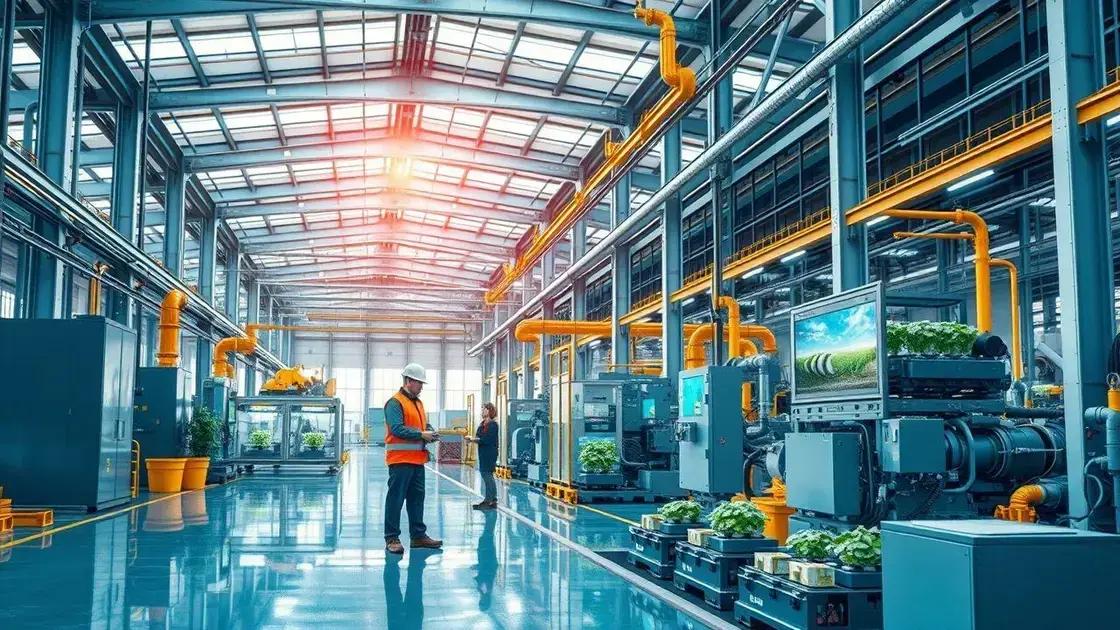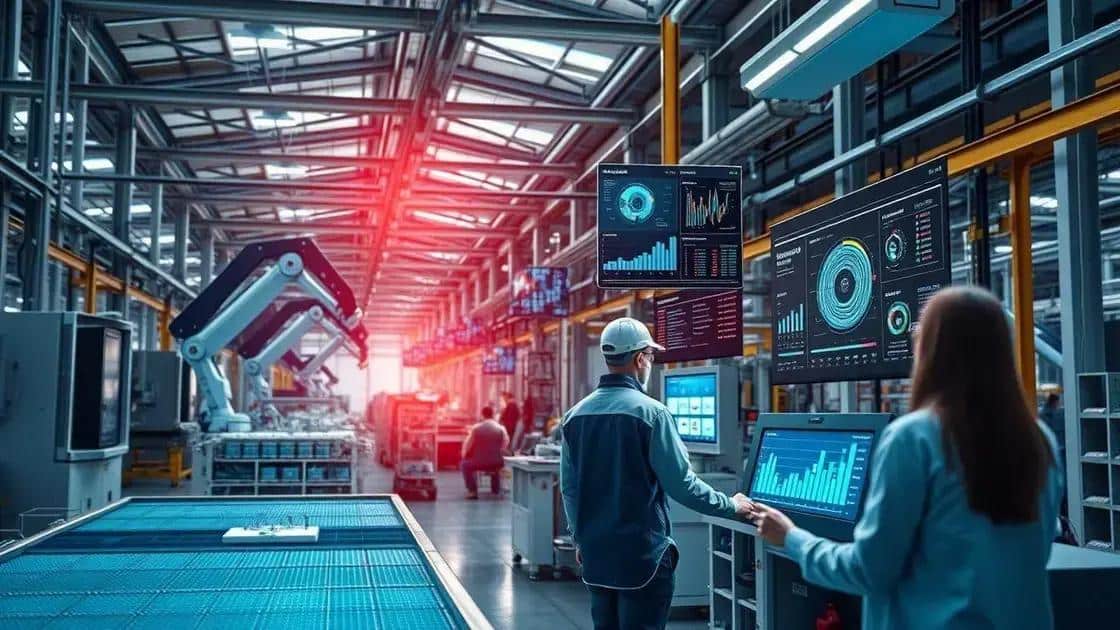Biden’s initiative to revitalize American manufacturing

Anúncios
Biden’s initiative to revitalize American manufacturing focuses on enhancing local production, creating jobs, and promoting sustainability through advanced technology and workforce development strategies.
Biden’s initiative to revitalize American manufacturing has sparked discussions about the future of jobs and innovation in the U.S. Have you wondered how these changes could affect your community and the economy as a whole?
Anúncios
Overview of Biden’s initiative
The Overview of Biden’s initiative to revitalize American manufacturing reveals essential strategies aimed at restoring jobs and fostering innovation across the country. By focusing on strengthening supply chains and investing in new technologies, this initiative seeks to position the U.S. as a leader in the global manufacturing sector.
Key Components of the Initiative
This initiative includes various elements designed to enhance productivity and sustainability. These components focus on economic growth while ensuring environmental responsibility. Here are some key aspects:
Anúncios
- Investment in clean energy technologies
- Tax incentives for companies that create jobs
- Support for workforce training programs
- Encouragement of domestic production
Moreover, the emphasis on innovation aims to modernize facilities and increase operational efficiency. As manufacturing evolves, companies are encouraged to adopt advanced practices to stay competitive. This includes leveraging automation and smart technologies to enhance production processes.
Impact on American Workers
Another vital aspect is the impact on American workers. As factories demand a skilled workforce, training programs will play a crucial role. Investing in education ensures that employees are equipped to handle new technologies. This not only boosts job security but also enhances career growth opportunities.
The initiative’s focus extends beyond just employment numbers; it aims to improve the overall quality of jobs available. By fostering a dynamic workplace, workers will benefit from better working conditions and competitive wages.
Through consistent support and policies, the initiative aims to help various communities thrive. By concentrating on local needs and sustainability, initiatives will be tailored to each region, ensuring equitable growth.
Key benefits for American manufacturing

The key benefits for American manufacturing under Biden’s initiative are crucial for revitalizing the economy. This initiative promises to strengthen local industries and create stable jobs. With a focus on innovation and sustainable practices, the U.S. manufacturing sector can look forward to a brighter future.
Economic Growth
One of the main advantages is economic growth. By encouraging manufacturing on U.S. soil, the initiative helps boost local economies. When factories thrive, the whole community reaps the rewards through more job opportunities and increased spending. A strong manufacturing sector contributes significantly to the nation’s GDP.
- Increased job creation
- Higher average wages
- Enhanced local economic stability
- Strengthened supply chains
Additionally, investing in advanced manufacturing technologies leads to greater efficiency. Companies can produce goods faster and with higher quality. This advancement fosters competition and drives prices down for consumers, ultimately benefiting everyone.
Environmental Sustainability
A remarkable aspect of this initiative is its commitment to environmental sustainability. By promoting clean energy technologies, manufacturing processes can become more sustainable. This shift not only meets consumer demand for greener products but also reduces the carbon footprint of factories.
As industries adopt better practices, they contribute to a healthier planet. This commitment helps American manufacturing align with global sustainability goals. The push for environmentally friendly practices attracts investments from consumers and businesses who prioritize sustainability.
In summary, the initiative provides various benefits that enhance economic resilience and sustainability. By focusing on both job creation and environmental responsibility, American manufacturing stands to gain significantly from these efforts.
Challenges faced in implementation
The challenges faced in implementing Biden’s initiative to revitalize American manufacturing are significant. While the goals are promising, several hurdles need addressing to ensure success. Without a thoughtful approach, the intended outcomes may fall short.
Supply Chain Issues
One of the major challenges is supply chain disruptions. Many manufacturers rely on global supply chains, and recent events have shown vulnerabilities. Companies must adapt quickly to these changes to maintain production levels. Addressing supply chain issues involves:
- Finding reliable domestic suppliers
- Investing in local production capabilities
- Diversifying sourcing strategies
- Increasing inventory resilience
Moreover, manufacturers often face rising costs related to material procurement. This impacts pricing and profit margins, making it difficult to compete both locally and globally.
Workforce Development
Another key challenge is workforce development. As manufacturing technology advances, there’s a pressing need for skilled labor. Many existing workers may require additional training to operate new machinery and innovative systems effectively.
Creating effective training programs is essential. Companies need to invest in education and partnerships with local institutions to bridge the skills gap. This not only aids businesses but also enriches communities by preparing workers for the jobs of the future.
Resistance to change can also hinder progress. Some employees may be hesitant to adopt new technologies or processes. It’s crucial for companies to foster an inclusive culture that encourages adaptability and continuous learning.
Balancing these challenges requires strategic planning and collaboration among stakeholders. By addressing supply chain weaknesses and investing in workforce training, the initiative can move forward more successfully.
Future outlook for American factories

The future outlook for American factories is filled with potential as Biden’s initiative gains traction. As technology advances and new strategies are implemented, the American manufacturing landscape is likely to change significantly. This evolution promises both challenges and opportunities for growth.
Technological Integration
One of the most exciting aspects of the future is the role of technology. Many factories are increasingly adopting smart manufacturing. This involves using data analytics, artificial intelligence, and automation to streamline processes and improve efficiency.
- Smart sensors can monitor machinery and prevent breakdowns.
- Automation allows for faster production with fewer errors.
- Data analytics helps in making informed decisions.
- 3D printing can reduce waste and lead times for production.
With these innovations, factories can become more competitive in a global market, enhancing their ability to respond to consumer needs quickly.
Workforce Evolution
As American factories move forward, the workforce will also need to adapt. New skills will be in demand as technology evolves. Educational programs will play a vital role in preparing workers for these changes. Companies must invest in training and development to ensure their employees are equipped with the necessary skills.
Collaboration between businesses and educational institutions will be crucial. Offering internships and apprenticeships can bridge the gap and prepare the next generation of skilled workers. Engaging with younger generations helps to promote interest in manufacturing careers.
Biden’s initiative strengthens local manufacturing by focusing on the importance of community and sustainability. The future looks bright for American factories that embrace change, invest in their workforce, and adopt new technologies. Growing interest in U.S.-made products adds further value, as consumers increasingly prioritize quality and sustainability.
FAQ – Frequently Asked Questions about Biden’s Initiative to Revitalize American Manufacturing
What are the main goals of Biden’s initiative?
The main goals include increasing local production, creating jobs, and promoting environmental sustainability through advanced manufacturing practices.
How will technology impact American factories?
Technology will enhance efficiency and productivity, with smart manufacturing solutions allowing for better data analysis and automation in production.
What challenges does the manufacturing sector face?
Challenges include supply chain disruptions, the need for workforce training, and adapting to new technologies.
How can the initiative benefit local communities?
By revitalizing manufacturing, local economies can benefit from job creation and increased demand for U.S.-made products, leading to overall economic growth.






